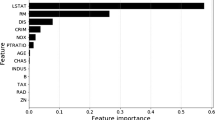Abstract
The paper considers the least absolute deviations estimator in a nonlinear parametric regression. The interest of the LAD method is its robustness with respect to other traditional methods when the errors of model contain outliers. First, in the absence of change-points, the convergence rate of estimated parameters is found. For a model with change-points, in the case when the number of jumps is known, the convergence rate and the asymptotic distribution of estimators are obtained. Particularly, it is shown that the change-points estimator converges weakly to the minimizer of given random process. Next, when the number of jumps is unknown, its consistent estimator is proposed, via the modified Schwarz criterion.
Similar content being viewed by others
References
Andrews D.W.K., Lee I., Ploberger W. (1996) Optimal changepoint tests for normal linear regression. Journal of Econometrics 70: 9–38
Babu G.J. (1989) Strong representations for LAD estimators in linear models. Probability Theory and Related Fields 83: 547–558
Bai J. (1995) Least absolute deviation estimation of a shift. Econometric Theory 11: 403–436
Bai J. (1998). Estimation of multiple-regime regressions with least absolute deviation. Journal of Statistical Planning Inference 74: 103–134
Bai J., Perron P. (1998) Estimating and testing linear models with multiple structural changes. Econometrica 66: 47–78
Carlstein E., Muller H.G., Siegmund D. (1994) Change-point problems. IMS, Hayward
Csōrgo M., Horváth L. (1997) Limit theorems in change-point analysis. Wiley, New York
Dielman T.E. (2005) Least absolute value regression: recent contributions. Journal of Statistical Computation and Simulation 75(4): 263–286
Epps T. (1988) Testing that a Gaussian process is stationary. The Annals of Statistics 16: 1667–1683
Garcia R., Perron P. (1996) An analysis of the real interest rate under regime shifts. Review of Economics and Statistics 78: 111–125
Hitomi K., Kagihara M. (2001) Calculation method for nonlinear dynamic least-absolute deviations estimator. Econometric Theory 7: 46–68
Horváth L., Hušková M., Serbinowska M. (1997) Estimators for the time of change in linear models. Statistics 29(2): 109–130
Horváth L., Hušková M., Kokoszka P., Steinebach J. (2004) Monitoring changes in linear models. Journal of Statistical Planning Inference 126(1): 225–251
Hušková M., Prášková Z., Steinebach J. (2007) On the detection of changes in autoregressive time series. I. Asymptotics. Journal of Statistical Planning Inference 137(4): 1243–1259
Kim H.K., Choi S.H. (1995) Asymptotic properties of non-linear least absolute deviation estimators. Journal of the Korean Statistical Society 24: 127–139
Kühn C. (2001) An estimator of the number of change points based on a weak invariance principle. Statistics and Probability Letters 51(2): 189–196
Lavielle M. (1999) Detection of multiple changes in a sequence of dependent variables. Stochastic Processes and their Applications 83: 79–102
Liu J., Wu S., Zidek J.V. (1997) On segmented multivariate regressions. Statistic Sinica 7: 497–525
Lombard F. (1987) Rank tests for change point problems. Biometrika 74: 615–624
Mia B., Zhao L. (1988) Detection of change points using rank methods. Communications in Statistics. Theory and Methods 17: 3207–3217
Oberhofer W. (1982) The consistency of nonlinear regression minimizing the L 1-norm. The Annals of Statistics 10(1): 316–319
Pauler D.K., Finkelstein D.M. (2002) Predicting time to prostate cancer recurrence based on joint models for non-linear longitudinal biomarkers and event time outcomes. Statistics in Medicine 21(24): 3897–3911
Pollard D. (1991) Asymptotics for least absolute deviation regression estimators. Econometric Theory 7: 186–199
Richardson G.D., Bhattacharyya B.B. (1987) Consistent L 1-estimators in non-linear regression for a noncompact parameter space. Sankhya:The Indian Journal of Statistics, Series A 49: 377–387
Serbinowska M. (1996) Consistency of an estimator of the number of changes in binomial observations. Statistics and Probability Letters 29(4): 337–344
Weiss A.A. (1991) Estimating nonlinear dynamic models using least absolute error estimation. Econometric Theory 7: 46–68
Wu Y. (1988) Strong consistency and exponential rate of the minimum L 1-norm estimates in linear regression models. Computational Statistics and Data Analysis 6: 285–295
Yao Y.C. (1988) Estimating the number of change-points via Schwarz’s criterion. Statistics and Probability Letters 6: 181–189
Yao Y.C., Au S.T. (1988) Least-squares estimation of a step function. Sankhya 51: 370–381
Author information
Authors and Affiliations
Corresponding author
About this article
Cite this article
Ciuperca, G. Estimating nonlinear regression with and without change-points by the LAD method. Ann Inst Stat Math 63, 717–743 (2011). https://doi.org/10.1007/s10463-009-0256-y
Received:
Revised:
Published:
Issue Date:
DOI: https://doi.org/10.1007/s10463-009-0256-y




